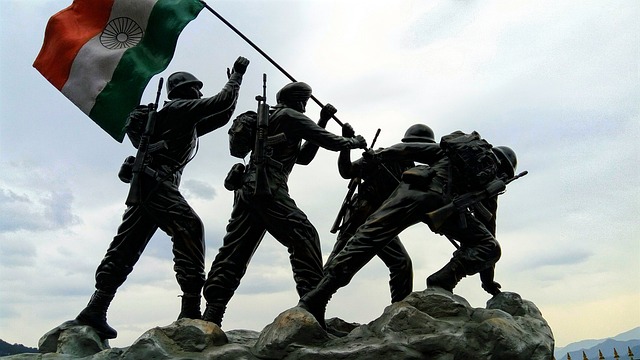The 82nd Airborne Division Flag, adopted in 1975, is a vibrant symbol of the division's history and achievements in conflicts from World War II to the Middle East. Its bold colors and precise imagery highlight airborne roots, with wings and parachutes representing rapid deployment and air assault tactics. The flag serves as a critical component in military operations, boosting morale, aiding navigation, and fostering camaraderie among troops, while holding immense cultural and historical weight for the United States Army.
“Unveiling the Iconic 82nd Airborne Division Flag: A Symbol of American Military Might
The official flag of the United States Army’s 82nd Airborne Division stands as a testament to its rich history and formidable prowess. This article delves into the historical background of this esteemed division’s flag, exploring its design elements and profound symbolism. We’ll uncover how the flag plays a pivotal role in military operations, fostering camaraderie and inspiring courage. Additionally, we’ll examine its lasting impact on U.S. Army culture, solidifying its place as an enduring symbol of the 82nd Airborne’s legacy.”
- Historical Background of the 82nd Airborne Division Flag
- Design Elements and Symbolism
- The Flag's Role in Military Operations
- Impact and Legacy on U.S. Army Culture
Historical Background of the 82nd Airborne Division Flag

The 82nd Airborne Division’s flag holds a rich historical background, reflecting its pivotal role in military operations. Adopted in 1975, this symbol represents the division’s proud heritage and notable achievements. The flag features a distinctive design with bold colors and precise imagery, paying homage to the unit’s airborne roots and its contribution to various conflicts.
Historically, the 82nd Airborne Division has been at the forefront of numerous pivotal missions. From its inception during World War II to subsequent deployments in Vietnam and the Middle East, the division’s flag has become a recognizable emblem of American military prowess. The design incorporates elements that signify airborne operations, such as wings and parachutes, symbolizing the unit’s capabilities in rapid deployment and air assault tactics.
Design Elements and Symbolism

The official flag of the United States Army is a rich tapestry of symbolism, reflecting the history, values, and mission of America’s landforce. At its heart lies the emblem of the 82nd Airborne Division, prominently featured in bold colors. This division flag boasts a unique design with multiple elements that hold deep significance. The background is a striking red, symbolizing courage and sacrifice, while the central image is a white parachute, representing the Division’s airborne capabilities and the sky as a realm of operation.
The 82nd Airborne Division’s insignia, often seen on military uniforms, is also incorporated into the flag design. This insignia typically includes an eagle, standing tall and proud, with wings outstretched, symbolizing strength and sovereignty. The eagle holds a shield in its talons, depicting 13 alternating red and white stripes, representing the original colonies, and a blue field with stars, honoring the United States’ union. These elements collectively convey the Army’s readiness to deploy worldwide, embodying the spirit of freedom and protection that the flag represents.
The Flag's Role in Military Operations

The official flag of the United States Army serves as more than just a symbol; it plays a critical role in military operations, embodying the values and heritage of the nation’s land forces. This flag, with its distinct design and colors, holds immense significance for soldiers, both historically and in contemporary contexts. For instance, the 82nd Airborne Division Flag, recognized globally, stands as a beacon of resilience and bravery, reflecting the division’s storied history and unique capabilities.
During military operations, the flag functions as a powerful morale booster, instilling a sense of pride and camaraderie among troops. It also serves as a recognizable mark, aiding in navigation and communication on the battlefield. The presence of the US Army flag can inspire loyalty, strengthen unit bonds, and foster a collective determination to accomplish mission objectives, making it an indispensable tool for fostering cohesion and spirit within military units.
Impact and Legacy on U.S. Army Culture

The official flag of the United States Army, incorporating the distinctive 82nd Airborne Division banner, holds profound significance within the military culture and history of the nation. This emblem serves as a powerful symbol of unity, courage, and the shared heritage of all those who have served or are currently serving in the Army. The vibrant colors and meticulously designed elements convey important messages about the branch’s core values, traditions, and capabilities.
The 82nd Airborne Division Flag, in particular, has left an indelible mark on U.S. Army culture, reflecting its rich combat history and unique role in various military operations worldwide. The division’s heritage is deeply rooted in airborne tactics, symbolizing the agility, precision, and adaptability required to execute daring missions behind enemy lines. This legacy inspires current and future soldiers, fostering a sense of pride and camaraderie that transcends generations.
The 82nd Airborne Division Flag, with its rich history and powerful symbolism, stands as a symbol of resilience, bravery, and unity within the U.S. Army. Its design elements, reflecting the division’s heritage and achievements, play a crucial role in fostering camaraderie among soldiers and inspiring them during military operations. The flag’s impact extends beyond the battlefield, leaving an indelible mark on Army culture by embodying the values of courage, sacrifice, and mission accomplishment. As a testament to the 82nd Airborne Division’s legacy, this emblem continues to guide and motivate future generations of soldiers.
